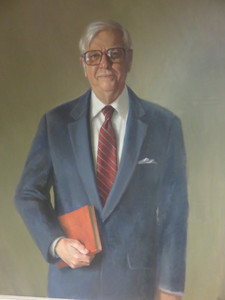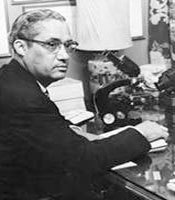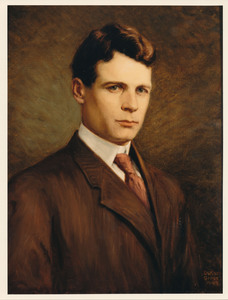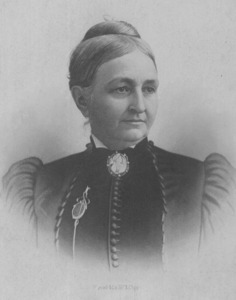By: Katherine Lattal, Galter Library Special Projects / Library Assistant
Northwestern University Feinberg School of Medicine has four Medical Student Societies, each named in honor of a notable alumnus. Learn more about these alumni below.
John A.D. Cooper, MD, PhD (1909-2002)
 Dr. Cooper was the first full-time physician president of the Association of American Medical Colleges (AAMC), serving from 1969 until his retirement in 1986. Cooper grew up in El Paso, Texas and attended New Mexico State University. After graduation, he served with the Army during World War II. In 1943 he earned his PhD in biochemistry from Northwestern University and in 1951 completed his MD at Northwestern as well.
Dr. Cooper was the first full-time physician president of the Association of American Medical Colleges (AAMC), serving from 1969 until his retirement in 1986. Cooper grew up in El Paso, Texas and attended New Mexico State University. After graduation, he served with the Army during World War II. In 1943 he earned his PhD in biochemistry from Northwestern University and in 1951 completed his MD at Northwestern as well.
Cooper joined Northwestern as a physician and an associate professor in biochemistry after earning his MD, rising to a full professorship a few years later, and then serving first as an assistant dean and later as an associate dean. Subsequently his role as an educator, administrator, and policymaker expanded and he soon became known as an expert on medical education and curriculum. Over the course of his career he published over 300 articles on medical research, education, and policy.
In 1969 Cooper was recruited by AAMC to become their first full-time executive with physician experience. He transformed it into an organization with national influence and lobbying power in Washington, D.C. that advocated on behalf of medical schools and students, health sciences libraries, and teaching hospitals. Cooper led AAMC to craft important national policy regarding medical education and training and in 1981 he was named one of the five most influential people in that field by U.S. News & World Report.
Cooper was awarded 12 honorary degrees and won numerous awards, including the Northwestern University Alumni Medal in 1976. His portrait hangs on the second floor of the Galter Health Sciences Library.
Theodore Kenneth Lawless, MD, MS, DSc, LLD (1892-1971)
 Dr. Lawless was a renowned African-American dermatologist, businessman, and philanthropist. Lawless, who went by T.K., grew up in New Orleans, earned his AB at Talladega College and went on to study medicine at the University of Kansas. He completed his MD at Northwestern in 1919 and also earned an MS in 1920. After studying dermatology at prestigious institutions in New York, Boston, Paris, and Vienna, Lawless returned to Chicago in 1924 to enter practice, teach, and conduct research. He taught dermatology at Northwestern for over 15 years and was the first to establish a clinical laboratory at the medical school. His work focused on finding a cure for leprosy and advancing treatments for leprosy, skin conditions, and syphilis.
Dr. Lawless was a renowned African-American dermatologist, businessman, and philanthropist. Lawless, who went by T.K., grew up in New Orleans, earned his AB at Talladega College and went on to study medicine at the University of Kansas. He completed his MD at Northwestern in 1919 and also earned an MS in 1920. After studying dermatology at prestigious institutions in New York, Boston, Paris, and Vienna, Lawless returned to Chicago in 1924 to enter practice, teach, and conduct research. He taught dermatology at Northwestern for over 15 years and was the first to establish a clinical laboratory at the medical school. His work focused on finding a cure for leprosy and advancing treatments for leprosy, skin conditions, and syphilis.
In addition to his medical work, Lawless had many business interests in Chicago. He was the director of the Supreme Life Insurance Company, charter member and director of the Marina City Bank, president of the 4213 South Michigan Corporation, and president of the Service Federal Savings and Loan Association.
As Lawless’ wealth grew, so did his philanthropy. Believing that black students in the South were more disadvantaged than those in the North, Lawless directed his philanthropy toward educational institutions across the southern United States—though he did not overlook Chicago and donated to youth organizations in the city. He also directed his philanthropy to Jewish institutions in the United States and Israel because as a young physician he had received help, advice, and camaraderie from peers of Jewish heritage.
Lawless received five honorary degrees and earned many awards for his philanthropy and work in medicine and business, most notably winning the Springarn Medal, the NAACP’s highest honor, in 1954.
Howard Taylor Ricketts, MD (1871-1910)
 A ground-breaking pathologist and researcher, Dr. Ricketts died while studying the transmission of typhus. He was affiliated with Northwestern for much of his education, attending the Northwestern University Academy and College for high school and Northwestern University for the first two years of his undergraduate degree, and he returned to Northwestern to earn his MD in 1897. Ricketts studied in Vienna, Berlin, and Paris before returning to the United States to take a position at the University of Chicago.
A ground-breaking pathologist and researcher, Dr. Ricketts died while studying the transmission of typhus. He was affiliated with Northwestern for much of his education, attending the Northwestern University Academy and College for high school and Northwestern University for the first two years of his undergraduate degree, and he returned to Northwestern to earn his MD in 1897. Ricketts studied in Vienna, Berlin, and Paris before returning to the United States to take a position at the University of Chicago.
Before his seminal work on typhus, Ricketts studied Rocky Mountain spotted fever in Montana. Many of the ideas that Ricketts brought to his study of typhus were founded in his work on this disease. He determined how the disease was transmitted, isolated the bacillus responsible and how it acted, and even invented prevention methods. All of this he accomplished in just three years, impressive since his lab facilities were simple tents pitched in a hospital’s courtyard. The scientific community honored Ricketts’s work on infectious agents by naming the taxonomic order Rickettsiales and the family Rickettsiaceae after him.
Ricketts has been hailed as a medical martyr who sacrificed his life in the pursuit of scientific discovery. Ricketts traveled to Mexico City during an outbreak of typhus to study its transmission. He died there on May 3, 1910 after contracting typhus from an infected insect in his lab. Days before his untimely passing, he and his assistant had announced that they had discovered the microorganism responsible for typhus. Ricketts was the first to isolate the causative microorganism of typhus and was one of the first to discover that typhus was spread via the body louse. In the pre-antibiotic era, typhus was an epidemic disease, and Ricketts’s findings helped to reduce the spread of typhus and thus combat outbreaks. Just four years later, the absence of typhus on the Western Front in World War I shows how significant Ricketts’s discovery really was.
Mary Harris Thompson, MD (1829-1895)
 Dr. Thompson was the first known woman to perform major surgery in the United States. Thompson grew up in New York and before pursuing a career in medicine she worked as a teacher. In 1863 she earned her MD from the New England Female Medical College in Boston and gained practical experience treating patients at the New York Infirmary for Women and Children.
Dr. Thompson was the first known woman to perform major surgery in the United States. Thompson grew up in New York and before pursuing a career in medicine she worked as a teacher. In 1863 she earned her MD from the New England Female Medical College in Boston and gained practical experience treating patients at the New York Infirmary for Women and Children.
Thompson decided to start her practice in Chicago and after her arrival in the city she observed an acute need for a hospital dedicated to women’s and children’s health. In 1865 she founded the Chicago Hospital for Women and Children, the first hospital staffed by female physicians, and served as the head surgeon and physician.
In 1869 she and two other women attended courses at Chicago Medical College, the predecessor to Feinberg School of Medicine. The admittance of these women was viewed as an experiment in co-education, and soon many male students and faculty complained that their presence inhibited discussion of certain ‘indecent’ topics and thus impeded their own medical education. Thompson and the other women were not allowed to return to classes. Because Thompson had already earned her MD elsewhere, at the end of the 1869-70 school year she was granted an ad eundem degree from Northwestern, a customary practice at the time. She was the first woman to earn a degree from the medical school, and remained so until it became fully co-ed in 1926.
Seeing another gap in women’s services in Chicago, in 1870 Thompson, along with Dr. William Byford from the Chicago Medical School, established the Woman’s Medical College, which was affiliated with Thompson’s hospital. Four years later she helped found the first nursing school in Chicago, as well. After her death, the hospital she founded was renamed the Mary Thompson Hospital and was in operation until 1988.
To learn more about these individuals, FSM history, or the history of medicine, please contact Special Collections at Galter Health Sciences Library at ghsl-specialcollections@northwestern.edu.
Updated: September 25, 2023